 Individual Cigars
Individual Cigars
Individual cigars can be finished in various ways:
|
Plain Cigars
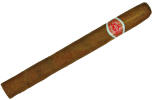
|
Cigar bands (Anillas) were introduced in Cuba circa 1870s.
Since mid-2006, all Cuban cigars have bands applied.
Between 2004 and 2006, slide lid boxes can be found either banded or unbanded.
Limited and Special Releases usually have a second band. Commemorative issues may have a special band
or a second band. On rare occasions, the bands may be numbered.
Plain cigars in dress boxes are "box pressed"; that is, squeezed down to form flat sides rather being
rounded.
|
Cellophane Sleeved
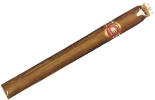
|
Cellophane sleeving of cigars commenced in Cuba in the mid-1930s and until c1992, most Cuban cigars
(even Cohibas) were available in cellophane sleeves.
Since c1992 the use of cellophane sleeving was restricted to machine-made cigars, which were
discontinued by Habanos c2002/2003. Cellophane is now used only for ICT machine-made Puritos.
|
Cedar Wrapped
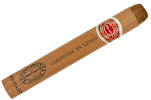
|
The wrapping of cigars in cedar sheet was intended to add a cedar aroma to the cigar.
The cedar sheet provides some protection against physical damage and may be left on when storing in a humidor.
|
Tissue Wrapped
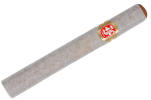
|
Only one brand is currently available tissue-paper wrapped, the Fonseca.
The wrapping adds nothing and provides negligible protection.
The tissue may be left on the cigars in a humidor, but must be removed before smoking.
|
Aluminium Foil Wrapped
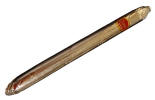
|
The use of true aluminium foil (for wrapping cigars) started in the 1920s but because of the high cost
to hand-wrap the cigars, its general use was replaced with cellophane
sleeves (except for premium or special cigars) by the 1940s.
Current aluminium foil is actually a naturally silver coloured aluminium paper foil.
It can be either plain or have an embossed pattern (stars etc.) and can
fully or partially wrap the cigar.
|
Gold Foil Wrapped
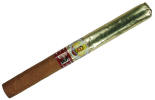
|
As above but a gold coloured aluminium paper foil is used.
The foil is either plain or patterned and to date has only been used to partly wrap the cigars.
|
Cedar Wrapped & Cellophane Sleeved
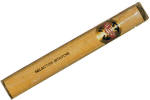
|
Cellophane sleeved cedar wrapped cigars generally indicate machine-made cigars.
This form of packaging has been discontinued.
|
Aluminium Tubes
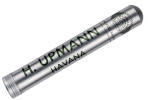
Standard Tube
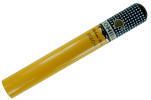
Premium Tube
|
Aluminium tubes first appeared in the mid-1940s and were quite common by the 1950s.
Some cigar releases are available exclusively in aluminium tubes, while other releases are
available either with or without tubes.
Tubes help to preserve cigars from physical damage and short-term drying out. Habanos recommends removing them from their tubes if storing in a humidor although MRN advocates leaving cigars in their tubes for improved (but slower) aging. Tubes have a thin cedar-sheet lining.
Since 2006, Habanos SA has been extending the available tube
range in their major brands, using both recoloured standard tubes and a new premium style tube.
Some of the minor brands are having the tubes withdrawn.
The standard tubes have a bottom screw-cap.
The older style tubes generally have black text printed on the natural silver
background while the newer style tubes have the same screw-cap
construction but with more colourful tube colour and printing.
The new premium tubes have a twin tube construction, with a top, friction pull-apart section.
They are usually printed in multiple colours.
|
Humidified Tubes
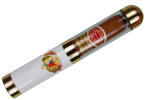
|
In 2008 a super-premium Humidifier Tube was released for the Travel Retail Selection pack.
It incorporates a rechargeable humidifier sponge within a double aluminium chamber, a clear plastic upper section
and a cap that incorporates a reusable cigar punch.
|
Glass Tubes
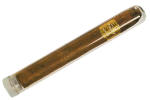
|
Glass tubes were introduced circa mid-1940s and became common in the 1950/1960s. Their use
was discontinued by the mid-1970s.
Glass tubes have a plastic push-in cap.
|
Plastic Tubes
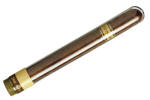
|
Plastic Tubes can be either clear or opaque, with push-top caps.
Their current use is limited to ICT machine-made cigars.
|
Cedar Tubes
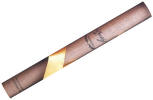
|
The cedar timber tube was a special release tube once used by the discontinued Davidoff brand.
|
Cardboard Boxes
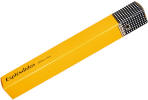
|
An individual "soft-pack" cardboard box, containing a single cigar.
These individual cardboard boxes are packed in Cardboard Packs of 3 or 5.
|
Small SLB
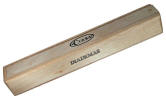
|
A small unvarnished solid or cedar plywood timber slide lid box, usually containing a single round cigar.
Also known as a "coffin box".
These boxes are packed in a 3 or 5 pack dress or slide lid box. Usually reserved for expensive or large cigars.
|
Small Varnished SLB
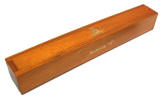
|
As above, but with a clear varnish finish.
|
Foil Wrapped in SLB
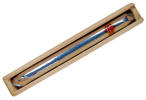
|
Unvarnished small slide lid box, containing one or more aluminium foil wrapped cigars.
|
Culebras
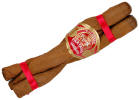
|
Culebras means "snakes" in Spanish and as a packing term means three cigars twisted together in a tight
intertwined spiral. Culebras is also the Cuban factory name for specific sized vitola.
Only three brands have produced Culebras since 1960. These were machine-made cigars. Early packaging was
a dress box of 25 containing eight spirals of three plus a single straight cigar, to
make up the total of 25 cigars.
The modern Culebras are handmade and each spiral bundle is packed in a small slide lid box.
|
Cellophane Bundles
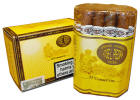
|
Cigars packed in cellophane wrapped bundles are now restricted to cheaper short-filler cigars.
Bundles normally consist of 25 cigars.
|
Aluminium Foil Bundles
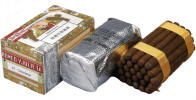
|
Aluminium paper foil bundles tend to be used for very strong and/or oily cigars.
Believed to slow down the fermenting process and retain flavours longer.
Currently only in use for a few cigar releases.
|
 Packaging Types
Packaging Types
Cigars are or were packaged for sale in the following various forms:
|
Dress Boxes

|
The Dress Box is the most common cigar box and normally contains 25 box pressed cigars.
Also known as a standard box, current box, labelled box or semi-plain box. The box
is "dressed" with specific paper labels and trimmings. Semi-plain more correctly
applies to pre-WW2 boxes, where the dressings did not cover the whole box.
Until the mid-1970s, the boxes were constructed from solid cedar, after which time it changed to cedar
veneered plywood. The paper dressing forms the hinge of the box and the lid is fixed with a nail.
Some boxes have a brooch clasp in lieu of a nail. Currently used for some production cigars (mainly
tubes) and some special release boxes. These boxes have thicker cedar plywood lids.
Cigars are usually in layers, but sometimes (albeit rarely) may be in foil bundles.
Boxes of 25 are normally in 2 layers (12 bottom, 13 top), boxes of 20 are normally in 2 layers of 10,
and boxes of 10 are normally in a single layer. Normally, tubed cigars are in 3 layers.
|
Slide Lid Boxes
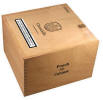
|
This is an unvarnished timber box normally containing 25 or 50 round cigars, packed in a bundle and tied with a
silk ribbon. Around 1997, the timber changed from solid cedar to cedar
veneered plywood.
Commonly referred to as a "Cab" (short for cabinet box).
Boxes of 25 & 50 normally contain bundled cigars tied with a silk ribbon. Some special releases and
discontinued production have cigars in Layers.
Boxes of 10 in a single layer and boxes of 20 in a double layer are referred to as Flat Slide Lid Boxes.
|
Varnished Slide Lid Boxes
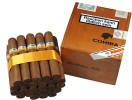
|
As above, but with a clear varnish finish to all sides, except the base.
|
Semi Boite Nature Boxes

|
An unvarnished timber box containing 10, 24, 25, or 50 round cigars in layers.
This box has a flat hinged lid (no sealing-collars) and is fitted with metal hinges & brooch clasp.
Around 1997, the timber changed from solid cedar to cedar veneered plywood.
Boxes of 10 are normally in a single layer whilst boxes of 25 are normally in a double layer.
|
Varnished Semi Boite Nature Boxes

|
As above, but with a clear varnish finish to all sides, except the base.
The Trinidad brand boxes of 12 & 24, packed in layers of 6, with a silk ribbon to assist cigar removal.
|
Boite Nature Boxes

|
A clear varnished finished cedar timber box normally containing cigars in layers.
This box has a formed metal hinged lid with projecting sealing collars and is fitted with a brooch clasp.
Boxes of 10 or 15 are normally in a single layer and boxes of 25 are normally in a double layer.
|
Varnished Boite Nature Boxes

|
As above, but with a clear varnish finish.
|
Lacquered Boite Nature Boxes

|
As above, but with an opaque lacquered gloss black finish.
|
Varnished 898 Boxes
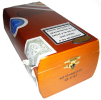
|
A varnished cedar timber box with the longer sides being curved, normally containing 25 round cigars, arranged
in 3 layers. They are fitted with metal hinges & a brooch clasp.
The original boxes of 25 cigars have layers of 8, 9 and 8 cigars; smaller boxes of 10 cigars have layers of 3, 4 and 3 cigars.
|
898 Boxes
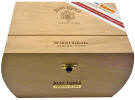
|
As above, but unvarnished.
Boxes of 50 have a ribbon tided bundle of cigars.
|
Cajóns
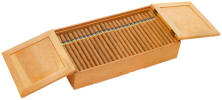
|
Cajóns of 50 and 100 (discontinued c1980s).
|
Humidors
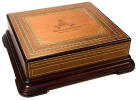
|
Special humidors can take many forms and are usually issued for a special occasion.
They are normally limited in quantity, carry a premium price surcharge and may contain vitolas not in normal production.
The cigars may have a special or an extra band.
The humidors are usually numbered and (rarely) the bands may be numbered.
There were also humidors of all forms, e.g. tree branches, etc.
|
Varnished Cabinets

|
Clear varnished cedar timber Cabinet, fitted with cedar sealing collars, metal hinges & a brooch clasp or slide lock.
The cigars are packed in layers.
|
Lacquered Cabinets

|
As above, but a gloss opaque lacquered finish.
These Cabinets are normally black, but some early Cabinets were finished with a green lacquer.
|
Special Boxes

|
A custom-made, cedar timber box for a particular (usually minor) release, typically containing a selection
of cigars taken from several brands.
|
Bundles

|
A cellophane wrapped bundle of cigars, with no other outer packaging.
Bundles (Mazos) normally contain 25 round cigars, with cigar bands since mid-2006.
Either wrapped in cellophane or silver paper foil. May be presented in a cardboard outer box or a
standard dress box.
|
Cardboard Boxes
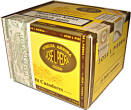
|
A "soft-pack" cardboard box, printed to look like a dress box, containing either a cellophane or
aluminium paper foil wrapped bundle of cigars.
|
Rigid Cardboard Boxes
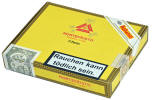
|
A rigid cardboard box, printed to look like a dress box, containing cigars in layer/s. Has a paper
hinge, but no nail or clasp.
Currently used by ICT for machine made cigars.
|
Cardboard Packs

|
Small, "soft" cardboard, flat, pocket-sized pack, with either a slide or flip-top. The packs may be wrapped in
cellophane and usually contain three or five plain or cellophane cigars. These packs are normally
available in lots of ten, in an outer box, suitable for retail display.
Cardboard Packs existed pre-Revolution but were phased out in the 1970s, and then reintroduced in the early
2000s. At the end of 2006, some packs were phased out.
Currently used for small packs of premium cigars (including Cohiba) for affordability, but also for
non-premium cigars for cheapness.
Packs for the range of small machine-made cigars (cigars less the 3 grams) are marked "Habanos S.A.", "HECHO
EN CUBA", and "Producido por Internacional Cubana de Tabacos bajo licencia de Habanos, S.A.".
They have the small version of the Cuban warranty seal (no serial number) on the pack.
|
Ceramic Jars
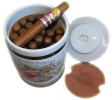
|
Ceramic Jars, first produced in the 1920s, were common in the 1950s and 1960s, but were phased out in
the 1980s. Their use was reintroduced in 1996.
Ceramic Jars have a push-on lid. They normally contain 25 cigars and occasionally 50 cigars.
Jars were produced by the following companies:
Talavera - used by Partagás from the 1920s.
Savilla - used by Partagás and Ramon Allones until the mid-1970s.
Bidasoa - used for the 1996 Cohiba 30 Aniversario and the 1999 Millennium releases.
Byron - used for Habanos SA jar releases since 2009.
Arzberg - used for the German Distributor 5th Avenue's Regional Edition jars.
|
Glass Jars

|
Glass jars were introduced c1910s, were common in the 1950s/60s, but were phased out by the mid-1970s.
They were reintroduced in 2009.
The jars are clear glass with a clip-on lid. Circa 1970 the lids changed from three clips
to two clips.
|
Plastic Cans
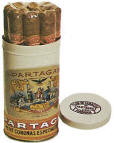
|
Plastic Cans containing cellophane sleeved cigars were available in the 1970s.
|
Metal Tins


|
Metal Tins are either circular or square with push-on lids, with
plain or cellophane cigars packed upright or laid flat.
This packaging was discontinued in the mid-1960s but reintroduced in 2013 for the new Vegueros packaging.
|
Aluminium Packs

|
Aluminium flat pocket-sized pack or case, either a hinged or slide unit, usually containing 5
cigars.
This style of packaging was discontinued in the mid-1980s. Larger packs of 50 & 100 were
apparently in use (details unknown).
|
Metal Packs
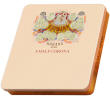
|
A metal, flat, pocket-sized pack or case, usually hinged and tipically containing 5 cigars.
|
Travel Humidors


|
The first Habanos Travel Humidor was released in 2006 with the introduction of
the Duty Free & Travel Retail series.
It includes leather bound humidors, special timber boxes and travel packs containing humidified tubes.
|
 Union and Warranty Seals
Union and Warranty Seals
The Union Seal was first introduced on 13th February 1889 by Royal Decree of the King of Spain to be used by the manufacturers (Union de Fabricantes de Tabaco).
A Provisional Seal is now known to exist during the period of United States' provisional administration
of Cuba, between 1898 and 1902.
The Warranty Seal was introduced in 1902 when Cuba gained formal independence from the United States.
In 1912 the Cuban Government authorised a new design, subsequently modified in 1931, 1999 and 2009.
Union Seal - 1889 to 1898
 |
This seal was introduced in 1889 when Cuba was still under Spanish control.
This seal had a portrait of Christopher Columbus on the right and the Coat of Arms of Spain and Habana on the left,
and was was used until Spain relinquished control following the end of the
Spanish-American War in 1898.
|
Union Seal - 1898 to 1902
 |
This seal is from the Office of the Provisional Governor of Cuba, the Provisional
Administration of the United States.
It was used until Cuba gained formal independence from the United States in 1902. |
Warranty Seal - 1902 to 1912
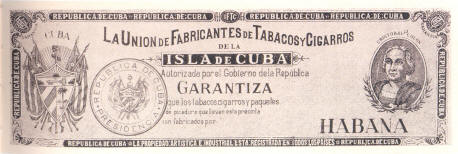 |
This warranty seal was introduced in 1902 when Cuba obtained its independence from Spain and remained in use until 1912.
It is a modification of the earlier Spanish seal.
The Spanish Coat of Arms replaced by the Republic of Cuba Coat of Arms and Seal
and is no longer over-printed with the factory name. |
Warranty Seal - 1912 to 1931
 |
This seal was introduced on 16 July 1912 by the new independent Cuban Government and remained in use until 1931.
It has a simplified Cuban Coat of Arms and a scene of a tobacco field in lieu of the Christopher Columbus portrait. |
Warranty Seal - 1931 to 1961
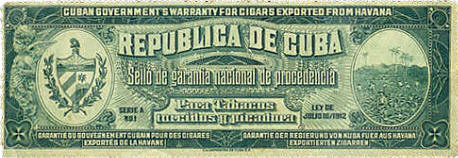 |
This seal was a modification of the previous seal and had perforated edges (like a stamp).
It was printed in four languages with dark green ink and was glued to the boxes. |
Warranty Seal - 1962 to 1999
 |
This seal is similar to the previous seal but without the perforations.
Over the years, due to wear and tear of the printing plates, the nine workmen visible in the field reduced until the 1980/1990s, when only five are clearly visible.
It was printed with a lighter shade of green ink
on a white paper, in 3 known sizes (+/-1mm): 182mm x 62mm & 97mm x 33mm for boxes,
and 60mm x 20mm for cardboard packaging.
The box seals were glued and the pack seals were self-adhesive. |
Warranty Seal - 1999 to 2009/2011 (overlaps with
following seal)
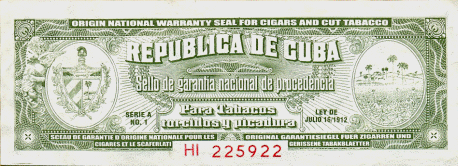
 |
This seal was introduced in late 1999. It was a major modification of the previous seal and incorporated more security features.
There are two sizes (148mm x 49mm for boxes and 60mm x 20mm for cardboard packs).
The smaller seal has no serial number.
|
The seals are manufactured with better quality self-adhesive
paper (two types of paper), micro-printing, a hidden ultra violet shield (two types), with the box seal bearing
a unique serial number printed in red ink, that has different reactions under UV light.
Currently there are several known variations of this seal:
i. Darker green shade of ink, printed on bright white paper, providing a good contrast.
Under UV light the paper fluoresces, a poorly defined pinkish-orange coloured shield appears and the whole serial number appears a very dark black-red.
ii. Lighter green shade of ink printed on creamy white paper, providing a less distinct appearance.
Under UV light the paper does not fluoresce, a well-defined lemon-yellow coloured shield appears, and the whole serial number appears a very dark black-red.
iii. Similar to ii, but under UV light the letters of the serial number remain a very dark black-red, but the numbers strongly fluoresce bright red.
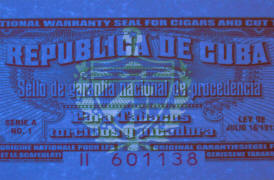 |
The hidden UV Image (incorrectly called a watermark) is located centrally and above the serial number.
It is a larger version of the printed shield. |
_-_Copy_-_Copy.jpg) |
The micro printing is present in 2 locations:
towards the top just above the "Republic de Cuba" text and near the
bottom below the "torcidos y picadura" text.
The micro
printing consists of "SELLO DE GARANTIA REPUBLICA DE CUBA" repeated
across the seal between the two scrolls. This is not readable
to the naked eye and is not overly distinct or clear under
magnification due to the printing process. The image shown is an extremely clear version of
the seal......generally it is not this clear. |
The serial number consists of two letters and six numbers and the first letter of the Serial Number should correspond with the following box date code; the second letter appears to be somewhat random. Any serial number on the warranty seal commencing with XX or XY has
been opened and inspected at the Habanos SA facility as part of their quality control and these boxes may have a "REVISADO" (reviewed) stamp on the base of the box.
| Box Date |
Serial Number Prefix |
| October 1999 on |
A |
| 2000 |
A |
| 2001 |
A, B, D |
| 2002 |
A, B, D |
| 2003 |
B, D, E |
| 2004 |
F, G |
| 2005 |
G, H |
| 2006 |
H, I |
| 2007 |
I, EZ |
| 2008 |
I |
| 2009 |
I, J |
| 2010 / 2011 |
J |
| NB. There is no known serial prefix "C" |
Warranty Seal - 2009 to circa late-2010


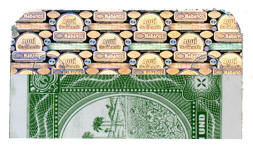 |
In 2009 Habanos SA commenced the introduction of a seal with
more security features. The previous seal, however, continued to be used until circa
2011. Many boxes were released with both seals, the new seal overlaying the old seal.
There are two sizes of seals: a 118mm x 35mm for dress boxes, cabinets, etc and a 58mm x 20mm seal for carton packs. Both new seals incorporate a hologram and the larger seal has a serialised barcode
and number in lieu of the previous serial number.
The smaller seal has no barcode (or serial number).
The serial numbers on the seal are unique numbers; they are not a product code (UPC or an EAN) number. There are
four different formats of this number. The validity of this number can be checked at:
http://www.habanos.com/Sellos/Info/VerificaSelloCajon
The seals are printed on a synthetic paper that is destroyed on removal. It incorporates a scan and photocopy protection system (presumably micro printing). The hologram displays a bicolour text (click
image to enlarge). |
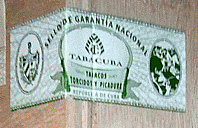 |
This generation of seal also saw the introduction of the transit seal, which is placed on the boxes at the factory before they shipped to a central warehouse where the main seal is applied, covering the transit seal.
|
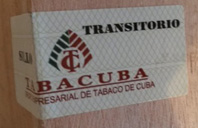 |
In 2014 the transit seal was updated with a new design.
|
Current Warranty Seal - circa late-2010 on
 |
In circa late-2010 Habanos SA modified the new hologram seal by bevelling-off the rounded corners, making
the seal some 2mm wider, and deleting the white boarder adjoining the hologram.
Like previous seals, it is likely that post-dated boxes with the older style seal will be found.
Overlapping of seal types is common while the old seals are used up.
|
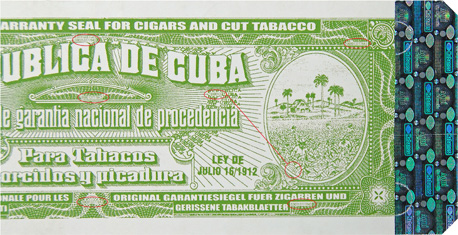
|
Starting in late 2011, the seal was revised to feature a micro-printed serial number at various locations on the design.
|

Pre-mid 2013

Post-mid 2013
|
In mid-2013, there was a change made to the seal holograms. The basic design remains the same, however, on the old style the "Habanos" appears blurred when looked at straight on, while the Aqui logo is fairly clear. On the new style holograms, the "Habanos" text is clear, while the Aqui logo appears blurred.
|
Seal Placement
Until 2009 seals were normally located on the left-hand side of the opening side of the box and positioned so that the fold is through the centre of the coat of arms.
If the cigar box comes packed inside an cardboard outer carton, the warranty seal is normally affixed to the
outer carton only.

The new seals are also be placed with the fold through the centre of the coat of arms, but with the barcode showing
at the front of the box, resulting in the seal being fixed in reverse of the previous seals.
There is a transition period between 2009 and 2011 when both the new & old seals
are affixed.
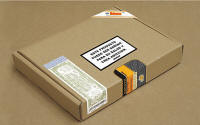
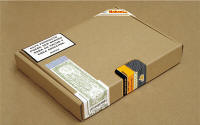
|